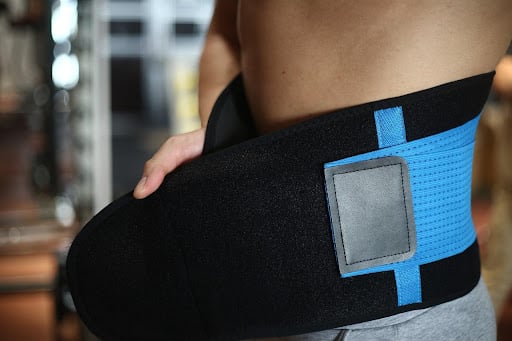Waist trainers are mostly used by women to slim down their waist and turn their bodies into an hourglass shape. Most fitness trainers suggest that you should wear a waist trainer eight hours a day to reap the benefits it offers.
However, some health professionals in the medical community suggest that wearing a waist trainer for extended periods can cause health problems. While you can sleep with a waist trainer on, it’s not ideal and you should refrain from doing so. Let’s discuss the topic in detail.
What is a Waist Trainer?

A waist trainer or a modern-day corset is a compression band that you wear around your midriff. The purpose of this garment is to squeeze your midsection and reshape it by force to achieve an hourglass figure.
Most waist trainers claim to help people with weight loss as well. The following are the main types of waist trainers available in the market that you can use.
Steel Boned Waist Trainers
These waist trainers come with flexible steel boning and feature the most traditional design. They also have tightening laces on the back or the sides and are commonly used to improve body posture.
Workout Waist Trainers
These trainers are less sturdy than steel-boned trainers and they feature a latex core. They’re commonly worn outside clothing and used by fitness enthusiasts.
Everyday Waist Trainers
An everyday waist trainer comes with hook-and-eye closures and a latex core and they’re typically worn under clothing. Most women use this type of waist trainers to instantly slim down their waistline.
Why Shouldn’t You Sleep with a Waist Trainer On?
As mentioned earlier, sleeping with a waist trainer can lead to several health problems. According to ABCS (American Board of Cosmetic Surgery), wearing waist trainers for a longer period of time can disfigure your body and harm vital organs. It can also fracture your ribs in the worst cases.
Wearing a tight waist trainer can affect your internal organ function, reduce lung capacity, weaken core muscles, and restrict the lymphatic system. In addition, it can hinder proper digestion by affecting acid reflux from stomach acid.
If you’re a heavy sleeper, you won’t be able to wake up to remove a waist trainer even if you’re feeling uncomfortable. Therefore, you should avoid sleeping with a waist trainer to ensure your health.
Are There Any Safe Ways to Sleep with a Waist Trainer?
If you really want to wear a waist trainer while sleeping to improve your figure in the shortest possible time, consider using the tips listed below.
Select the Right Waist Trainer
You don’t necessarily need to wear a steel-boned trainer to improve your figure. You can go with a short or looser waist trainer. A short waist trainer focuses only on your stomach area with its thin belt. It won’t cover your entire midriff to help you breathe easily while sleeping.
On the other hand, a looser/latex waist trainer comes with soft fabric and doesn’t feel too tight like steel-boned trainers. It’ll make you feel more comfortable while sleeping and won’t put a strain on your ribs and organs.
Use Pillows or Blankets
Depending on your comfortable sleeping position, you can place pillows or blankets on your bed strategically. It’ll improve your comfort and minimize the risk of health problems that can occur while sleeping with a waist trainer.
Here is how you can improve your sleeping space depending on common sleeping positions.
Stomach Sleeping Position
You should avoid sleeping on your stomach as it can cause back and neck pain. However, if you feel comfortable in this position, you should place an additional padding layer in your bed that covers your entire body except for the head.

You can use a soft blanket for this purpose. If your bed is already soft enough, consider sleeping without a pillow. The purpose of these adjustments is to keep your spine aligned with your head while wearing a waist trainer to sleep.
Read also: Does sleeping on your stomach make your butt bigger?
Back Sleeping Position
Sleeping on your back can affect the natural alignment of your backbone with your soft mattress. As a result, you won’t be able to sleep comfortably and it can also lead to lower back pain. You’ll need to support your lumbar area’s curve to combat this problem.
You can use a rolled-up towel or a small pillow under the small of your back. It’ll distribute your body weight evenly to take the pressure off your spine.
Read also: Does sleeping on your back make your butt flat?
Side Sleeping Position
Your body won’t be in a balanced position while side sleeping with a waist trainer. It can increase the pressure on your hips as they’ll be accommodating most of your body weight.
If you’re a side sleeper, you should place a soft body pillow under your waistline. It’ll ensure even body weight distribution to help you sleep comfortably while waist training.
Waist Training Benefits
You shouldn’t start your waist training journey without consulting with your doctor. It’ll allow you to reap all the benefits that wearing a waist trainer offers, including the following.
- Improve your body posture
- Accentuates your female features
- Improves confidence
- Reduces postpartum belly
- Offers more body support to women with larger features
FAQs
Should I Wear My Waist Trainer to Sleep?
Ideally, you shouldn’t wear a waist trainer while sleeping because it can lead to several health problems. However, choosing the right waist trainer and making adjustments in your sleeping space according to your sleeping position, can help you sleep comfortably with a waist trainer.
Does Waist Training Flatten Your Stomach?
Your stomach looks flat with a waist trainer. However, there is no scientific evidence to the claims that waist trainers burn belly fat or help you with weight loss.
Final Words
While you can sleep with a waist trainer, it’s not the best option because of the health problems it can cause. The ideal way to use a waist trainer is to wear it during the day and remove it before going to bed.
But if you really want to sleep with a waist trainer, consider using the tips discussed in this guide. It’ll allow you to sleep comfortably while waist training.
